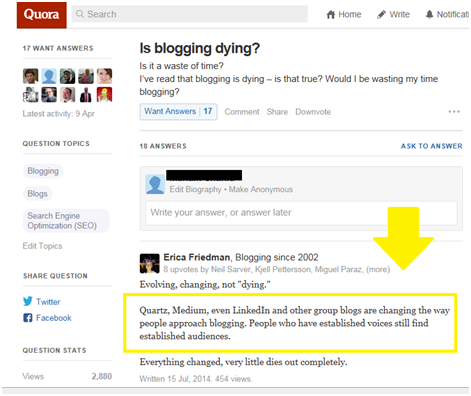It sucks. It really does.
I've been through this nightmare as well.
You want to increase traffic to your blog.
You've written blog posts BUT they haven't been discovered, loved and appreciated by the audience.
You have a small amount of readers. And an even smaller amount of engagement in the comment section, if any.
Why?
Others in your industry seem to be faring quite well. Their posts have long discussions, likes, and an unhealthy amount of social shares.
And, you're a pretty darn good writer yourself. So, why haven't you been able to do what they have managed to do so easily? Drive traffic to your blog, and get nice discussions flowing?
Something that makes your reader nod their heads and think, "WOW! This is exactly what I was looking for."
So, where have you been going wrong?
A couple of places actually. A lot of factors contribute to this nightmare you're having. In this digital world that's full of content -- stale and awe-inspiring, both -- the need to light up your own special show that everybody's queuing up in lines to attend is immense.
Writing kick-ass content no longer does it all.
It requires companions.
Friends. Foes. Minions.
All.
It requires you to:
Become a pimpled boy in the throes of his first love. Or second. Or millionth.
An overzealous teenage kid in the throes of his first love goes social media hunting (read, stalking) trying to find out everything he can about her.
Why?
So that he can impress her by pretending to love everything she loves.
And they live happily ever after. Or not.
Either way, he knows where he stands now. And after an hour of sulking and pretending to die, he bumps into the second love of his life. And on it goes, till he grows up.
Your audience is your love interest.
In order to impress them, to convince them to visit your blog, you NEED to know what they want.
What they're talking about.
That's how you'll figure out what they want to read about.
What excites them? What hooks them in and compels them to read further and further, till they become your loyalest readers?
WHAT ARE THEY PASSIONATE ABOUT?
So, where do you stalk them? How do you find the topics they're discussing presently? What subjects in your niche puzzle them? Befuddle them?
Join groups. Facebook Groups. LinkedIn groups. Google+ groups. Etc.
By now you know who your target audience is, so search for groups that they're a major part of. Once you get accepted to those groups, start searching for discussions that give you an insight to what your target audience wants to know about. Use the search option, and type in keywords related to your niche to see discussions that took place about it.
As a writer, I usually join entrepreneur groups and search for keywords related to writing -- copywriting, ghostwriting, blogging, SEO, and the works. This brings up a whole list of results that give me an insight to what my target audience wants to know. AND plenty of ideas to keep my blog alive and thriving for a couple of months, if not more.
And that, my friend, is what YOU have to do.
Quora. A writers' best friend.
I love Quora.
Why?
Because it's a Q&A platform that thrives on discussions and problems. It has never deserted me in my time of need. It has answers to every single thing I've searched for. How cool is that?
In order to fully utilize its potential, all you need to do is tap into the right discussion. Do a primary keyword search and choose a question from a long list of results that pop up. Read about users' most pressing concerns, and figure out a way you can address those concerns through a blog post.
Take this answer (the part in the yellow box) for instance. I can easily write an informative article on this answer alone, let alone the question (which has the potential to fill pages and pages).
Get comfortable in blogs' comment section
If you're not a Quora, or a social media kinda person (which makes you one in 3 billion people, maybe?) then chances are that you're a blog person.
Who's a blog person?
Someone who's always in hunt of great blogs. Well, if that's the case, then you're in great luck, because most blogs have a comment section; and the great ones have a pretty active comment section.
Find a blog that belongs to an influencer or an authority in your niche. Go through their recent blog posts, and read the comments. Look for comments that are blog-post-worthy,
and can wow your audience.
Writing content for EVERYONE does not serve much purpose. You need to narrow down your ideal readers, your target audience and write content that's tailor-made for them.
SO IT ALL BOILS DOWN TO ONE THING -- FINDING THE RIGHT SUBJECT FOR YOUR BLOG POST. ONE THAT RESONATES WELL WITH YOUR AUDIENCE.
To become best friends with her friends, so that she's forced to hang out with you.
Google is everybody's best friend. Even your target audience likes hanging out with Google.
So what's your next step?
Become Google's best-est friend.
And how do you do that? Through SEO.
Optimizing your content for search engines mean that when your target audience searches for a topic that you've already answered -- rather comprehensively and in an entertaining way, because you're a kick-ass writer -- via a blog post, Google will direct all that traffic to your blog.
You can optimize your blog post in 3 easy steps.
- Step 1: Find keywords that your target audience uses to search for your blog post. Use Adwords Keyword Planner, or Ubersuggest to search for keywords related to your niche.
- Step 2: Add these keywords in a natural way. They should synchronize happily with other words -- even a sniff of a forcefully entered keyword will raise a red flag, so STEER WELL CLEAR OF IT. Add these keywords to the,
- Headline
- Sub headings
- Images
- Meta-title
- After every 300 words or so
for some extra SEO magic.
- Step 3: Track and monitor your progress. Connect Google Analytics to your website by downloading the related plugin. Sit back and check if your tactics are working. If not, then tweak, test, repeat.
The key to mastering SEO is providing quality content to your readers, This is just a blueprint Google has given you to help you provide quality information to your readers. If your content is resonating well with your audience, then Google is bound to gift you a nice friendship bracelet.
To become the ultimate selfie master. The more happy selfies, the better.
70 percent of marketers plan to increase their use of visual assets in 2015
Why? Because visuals trump text.
The adage, pictures speak a thousand words, may make you cringe and you might even be tempted to roll your eyes, but you can't deny it's true.
Pouring over thick biology books for my O-level exam was a nightmare. I hated biology with a vengeance. The only thing that made this ordeal a little less nightmarish were pictures. Unpleasing and at times super-gross pictures (I'm not particularly fond of looking at human organs in all their bloody glory), but they at least reminded me which organs were which and what their functions were -- a feat that 600 pages of text could not achieve.
Conclusion: We remember visuals.
Just as our pictures remind us of a memorable time and pictures of human organs reminded me of the various functions of those organs; pictures related to your blog post will not only increase blog traffic but also leave a lasting impact on your audience.
So, what kind of visuals are we talking about here?
- Infographics
- Graphs
- Gifographics
- Short videos
- Screenshots
- Etc.
VISUALS RULE -- PLAIN TEXT, NOT SO MUCH.
Conclusion:
Driving traffic to your blog is hard.
Writing about it is easy, but putting it in action requires a dash of testing, a spoonful of awesome ideas, and a lot of patience.
You don't see results in a day or two, or even a week.
It's your turtle, and it will win, but like all turtles it needs time. So be patient.
And remember; test, tweak, repeat.
So, what are some tried and tested strategies that increased your blog traffic rapidly?




